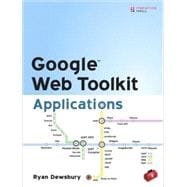
What is included with this book?
Ryan Dewsbury is a developer, architect, and consultant who started working in C++ and Java in 1998 and has used GWT since its first release. His recent projects include developing software applications with GWT (most notably gpokr.com and kdice.com). As a consultant, Ryan helps companies develop great online user experiences using cutting-edge software.
| Preface | |
| Understanding the Google Web Toolkit | |
| First Steps with the Google Web Toolkit | |
| User Interface Library Overview | |
| Server Integration Techniques | |
| Software Engineering for Ajax | |
| Using the Toolkit Effectively | |
| Rich Web Applications by Example | |
| Gadget Desktop | |
| Multi Search | |
| Blog Editor | |
| Instant Messenger | |
| Database Editor | |
| Index | |
| Table of Contents provided by Publisher. All Rights Reserved. |
The New copy of this book will include any supplemental materials advertised. Please check the title of the book to determine if it should include any access cards, study guides, lab manuals, CDs, etc.
The Used, Rental and eBook copies of this book are not guaranteed to include any supplemental materials. Typically, only the book itself is included. This is true even if the title states it includes any access cards, study guides, lab manuals, CDs, etc.